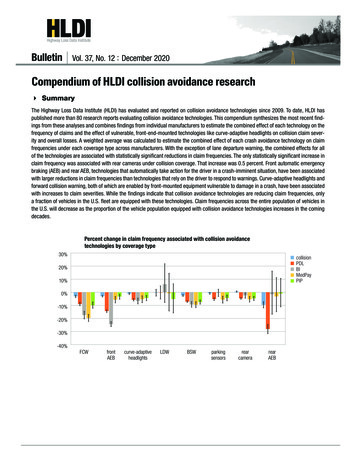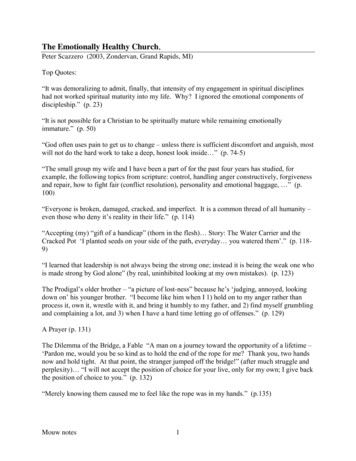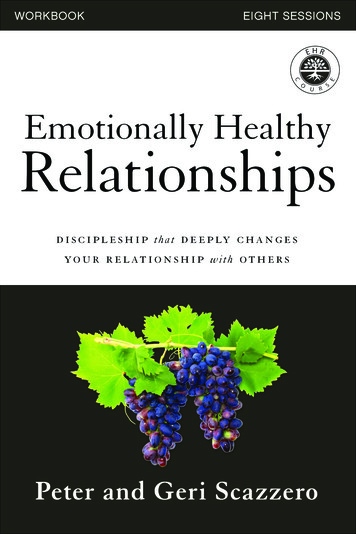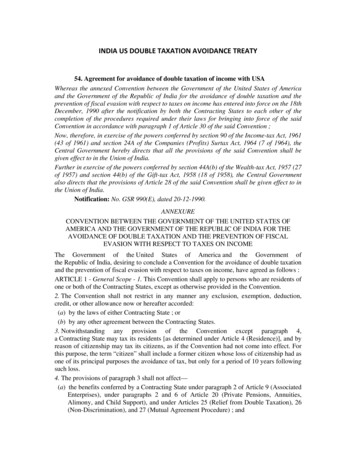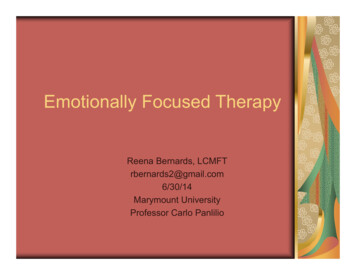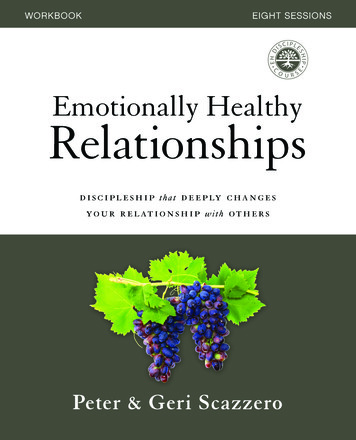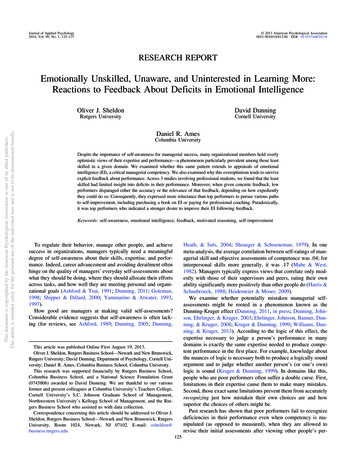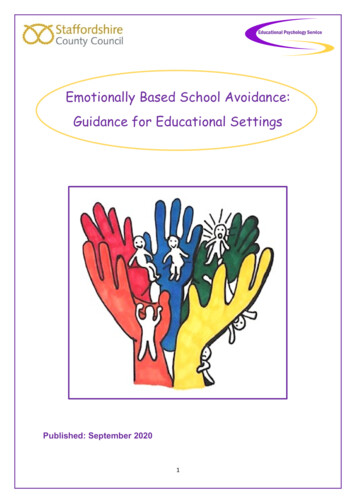
Transcription
Educational Psychology ServiceEmotionally Based School Avoidance:Guidance for Educational SettingsPublished: September 20201
Purpose/AimsStaffordshire County Council’s Recovery Plan has been devised in the context ofCOVID-19. This plan incorporates a number of projects across SCC services,including the Educational Psychology Service (EPS) to support educational settingsin the aftermath of emergency restrictions. The EPS have devised materials in anumber of areas with the aim of providing educational settings with support that canbe accessed immediately in the new academic year, without the need to refer intothe service directly.It is likely the extended absence from educational settings will have exacerbatedexisting needs linked to emotionally based school avoidance (EBSA), meaningintervention and support will be required to return pupils to regularattendance. Additionally, it is likely the contextual experience of COVID-19 will leadto increased numbers within the EBSA population.This document aims to provide educational settings with guidance that highlightsgood practice/recommendations/resources and enables them to work collaborativelywith parents/carers to support children and young people (CYP) with EBSA needs. Akey objective of the guidance is to facilitate educational settings in their planning,assessment and intervention with EBSA, at a school level.It is acknowledged that EBSA is a complex area of need and involvement from otherservices/professionals can be advantageous, appropriate and, at times, necessary.However, the aims/scope of the current guidance is to support early and effectiveintervention for the EBSA population, which could prevent the level of needescalating further and promote positive outcomes for the child or young person(CYP).2
Contents1.Background and Context1.1 Definitions and Terminology in EBSA . 41.2 Prevalence 41.3 Impact of EBSA 52.What is Anxiety?2.1 Anxiety and EBSA .73.EBSA in a COVID-19 Context3.1 Why EBSA Behaviours and Occurrence May Increase 94.Identification4.1 How do we identify EBSA?.4.2 Early Identification .11115.Factors Influencing EBSA5.1 Risk Factors .5.2 Protective Factors 5.3 Push and Pull Factors .5.4 Functions of School Non-Attendance .121415166.EBSA and Autism Spectrum Condition6.1 Changes in School Environment and Routines .6.2 Relationships 6.3 Regulation of Emotion .6.4 Sensory Differences 6.5 Special Interests .6.6 Main Messages 2021212222237.Working Collaboratively with Parents/Carers248.Eliciting the Child or Young Person’s Voice259.Strategies and Approaches9.1 Whole School Approaches .9.2 Supporting a Successful Return to School .9.3 Early Intervention .9.4 Transitions 9.5 Development of Social/Emotional Skills and Knowledge .9.6 Strengths and Interests .26283031333310.Useful Resources11.References12.Appendix3437393
1. Background and Context1.1 Definitions and Terminology in EBSAEmotionally based school avoidance (EBSA) is the term which will be usedthroughout this resource. This is a term used to describe those CYP who findattending school difficult due to emotional factors, including anxiety, which leadsthem to being absent from school for extended periods of time (West SussexEducational Psychology Service, 2018).This notion of school avoidance has been conceptualised in a wide variety of ways,and within the literature is referred to using a number of terms including ‘schoolrefusal’ and ‘school phobia’. ‘School refusal’ is commonly used; however, this can beseen to be problematic, as it implies wilful behaviour on the part of the CYP(Pellegrini, 2007). This suggests that individuals are choosing not to attend school,which implies the ‘problem’ is located within the child, rather than considering arange of wider environmental factors which may also support an individual to returnto school.Other terms such as ‘extended school non-attendance’, may also be used, whichcan be seen to be more neutral. However, through using this term to describe thosewho are not attending school due to emotional reasons, the risk is that the term mayalso include those who could be described as truants. Truants comprise of thosewhose lack of attendance may be more likely to relate to an unwillingness to conformto school expectations, or lack of motivation or interest, and fail to attend schoolwithout their parent’s knowledge (Elliott, 1999). This is in contrast to those presentingwith EBSA, where parents are aware of their child’s school absences, and suchindividuals do not present with ‘antisocial behaviour’ and do not attend due toexperiencing severe emotional distress at the prospect of going to school (Pellegrini,2007, Hughes et al., 2010).1.2 PrevalenceAttendance statistics released by the Department for Education (DfE, 2020), outlinesthat within England, ‘persistent absenteeism’ was at a rate of 10.9% during theacademic school year 2018/19. The DfE go on to define persistent absenteeism aswhen a pupil misses more than 10% of possible sessions within school. However,such statistics exploring ‘persistent absenteeism’, also include those children andyoung people absent from school due to truancy.Research further investigating the rates of EBSA within children and young people,estimate a range between 1 and 5% of school populations (Egger et al., 2003,Pellegrini, 2007, Elliott & Place, 2019). For example, using a large sample of 5,465,11–15-year olds, Havik et al (2015) found that one child in each class, approximately4% of the sample, reported being absent due to school refusal behaviour. However,4
some participants did not provide answers, and therefore, Havik et al. (2015)highlights how 4% may represent an underestimate.Pellegrini (2007) states EBSA is not specific to any particular population, sex,ethnicity or level of socio-economic status. School avoidance behaviours tend topeak at points of key transition, such as entry into primary school and when a pupilmoves into high school (Pellegrini, 2007). Other points of risk for EBSA may includemoving to a new school, or following a major holiday (King et al., 2001).1.3 Impact of EBSAEBSA can have a significant impact on CYP, in addition to the wider society(Pellegrini, 2007), and the negative outcomes of EBSA can affect an individual onboth a short and long-term basis (Hughes et al., 2010, Kearney, 2002). EBSA islikely to impact an individual’s social and emotional development, alongside theireducational progress. This may then subsequently affect an individual’s exam resultsand future career options (Miller, 2008, Nuttall & Woods, 2013, Pellegrini, 2007,Hughes et al., 2010).Furthermore, EBSA can also be associated with individuals leaving schoolprematurely (Kearney, 2006), in addition to also being at a greater long-term riskconcerning their mental health during adulthood (Flakierska-Praquin et al., 1997,McCune and Hynes, 2005).5
2. What is Anxiety?Mind.org.uk provides the following definition:‘Anxiety is what we feel when we are worried, tense or afraid – particularly aboutthings that are about to happen, or which we think could happen in the future.Anxiety is a natural human response when we perceive that we are under threat. Itcan be experienced through our thoughts, feelings and physical sensations.’Symptoms of anxiety can include: anxious thoughts, such as detailed mental pictures of a bad event, or thoughtsthat the person cannot cope or is not good enough feeling nervous, on edge, or panicky feeling overwhelmed and out of control having trouble sleeping low appetite finding it difficult to concentrate heart beating really fast having a dry mouth trembling stomach cramps wobbly legs getting very hotAnxiety is a normal human experience that, at lower levels (or higher ones that aretemporary), can be useful to us as a stress response linked to survival. It is a naturalreaction to something which is perceived as threatening. Anxiety helps prepare andmobilise the body for fight, flight or freeze by releasing a quick burst of the chemicaladrenaline.However, anxiety can become a problem when it moves beyond short-livedexperiences and begins to persistently interfere with everyday life. Such difficultiesare thought to be common. The charity Young Minds identified that 1 in 6 youngpeople will have significant anxiety at some point during their school life. Thisequates to 5 pupils in an average class of 30.6
2.1 Anxiety & EBSAThe term ‘school refusal’ is employed to refer to those for whom absenteeism isassociated primarily with emotional difficulties, particularly anxiety (Elliott & Place,2019). Maynard et al (2015) indicated that nearly 50% of clinic-referred youthcharacterised by school non-attendance have an anxiety disorder.When anxiety is linked to school avoidance, the young person may experienceanxious and fearful thoughts around attending school and their ability to cope withschool, which may be accompanied by physiological symptoms of anxiety.Separation anxiety can also be a precursor to school avoidance in some cases(Hella & Bernstein, 2012). In order to avoid these overwhelming emotions associatedwith school attendance the young person may withdraw from the situation, refusingto get ready for school or to leave the house or enter the school. The young personmay also turn to hostile behaviours as a means to avoid the threatening situation andto try and control what feels like a very ‘out-of-control’ situation (Thambirajah et al.,2008). These behaviours, and the avoidance of school, may then contribute to themaintenance of EBSA over time, as illustrated in the diagram below:Figure 1: Taken from ‘Supporting children with Anxiety in the COVID-19 Pandemic’ by Dr Tina Rae7
There may be one key trigger or several triggers for anxiety related to attendingschool, some examples include: Changes to class structure / teachers / routinePoor class behaviour / inconsistent classroom managementNot understanding workFear of getting something wrongFear of exams/poor performanceGroup activitiesBreak and lunchtimes (social anxieties)Bullying/peer pressureBeing away from loved ones for some reason (separation anxiety)In addition to identifying triggers, Heyne and Rollings (2002) suggest that it is crucialto consider the CYP’s perceptions of their ability to cope, including perceived socialand academic competence, as negative thoughts about one’s ability to cope canlead to further feelings of worry and if left unaddressed, may undermine attempts toimprove attendance.8
3. EBSA in a COVID-19 Context3.1 Why EBSA Behaviours and Occurrence may IncreaseThere are CYP in Staffordshire schools who, before the closure of schools due toCOVID-19, were avoiding school due to emotional needs. The extended period oftime that CYP have spent away from their educational setting and in the home islikely to exacerbate the difficulties attending school that this group of CYPexperience. In addition, for some CYP, learning at home will have felt safer and morecomfortable than the anxiety evoking experience of the school environment andrelated stressors. It is therefore anticipated that there is likely to be an increase inEBSA.Thoughtof schoolSense ofreliefFeelingsof dingschoolSense ofdreadFigure 2: The vicious cycle of thoughts, feelings and school avoidance behaviourThe figure above illustrates how thoughts and feelings influence behaviour. Thinkingabout returning to school may evoke difficult memories and prompt a plethora ofquestions, heightening anxiety and resulting in a physical response which mightinclude: increased heart rate rapid breathing sweating9
shaking nausea dizzinessThe CYP consequently fears going to school, anticipating it will result in challengingthoughts and feelings. The avoidance of thinking about or attending school leads to adecrease in anxiety and a sense of relief. These avoidance behaviours aresubsequently reinforced, as is the CYP’s perception that school is too difficult tomanage. Heightened anxiety could therefore result in a pattern of non-attendance asavoidance behaviours are maintained.The COVID-19 pandemic has led to unprecedented and unique circumstances, theemotional impact of which may intensify the impact of factors that were contributingto previous EBSA. The following factors might increase anxiety and maintain schoolavoidance behaviours: ‘Lockdown’ and social distancing measures resulting in overall feelings ofdisconnection with others Limited contact with school staff meaning there is a need to rebuildrelationships Interacting with peers in different ways leading to changes in relationships,and potentially peer-group dynamics, so there are concerns about friendships Reduced access to the curriculum meaning that the CYP has fallen behindwith school work, or is worried about catching up Concerns about catching or passing on COVID-19, being unwell or family andfriends becoming ill10
4. Identification4.1 How do we identify EBSA?It will be important to identify CYP who may be ‘at risk’ of EBSA as soon as possibleso that links can be made with the family to collaborate on a transition plan. Thisgroup of CYP might include: CYP who had a re-integration plan prior to school closure CYP whose attending was below 90% before school closed CYP with a history of: -attendance difficulties-anxiety-social communication and interaction difficultiesCYP whose parents/carers have expressed concernsIt is acknowledged there may be some CYP who did not previously present withattendance issues but begin to as school starts to re-open. It is therefore importantCYP who are not attending school as expected are identified and these concernsexplored.4.2 Early IdentificationThere may be signs that are noticed in CYP prior to the re-opening of schools and asCYP begin to re-attend including: Talking negatively about school Becoming anxious on separation from caregiver Physical symptoms of anxiety (e.g. headaches, stomach aches), often on aSunday night or a Monday morning, which may improve when the CYP stayshome from school Sharing worries about particular aspects of school Refusing to get ready for school Difficulties sleeping Becoming distressed when school is talked about Engaging in self-harming behaviours11
Becoming withdrawn, spending increasing amounts of time in their bedroom,avoiding trips outside of the homeEarly intervention is key. Baker and Bishop (2015) advocate a quick return to schoolalongside intervention, support and adaptations within the school and homeenvironment. Implementation of an individualised support plan, informed by ananalysis of the factors influencing EBSA, and developed collaboratively by families,school staff and the CYP has been shown to have positive outcomes.5. Factors Influencing EBSABadcock Integration LLP (2016) carried out case studies to develop an account ofrelevant factors for each CYP experiencing EBSA. Findings added to the existingresearch base which recognises that “for most, there are no clear or identifiable‘causes’ (of EBSA) but a complex interlinking of factors” . “linked to child, familycontext and school factors” (p.6)Factors influencing EBSA, according to the research, include: Risk and protective factors Four functions of school non-attendance (Kearney, 2008) ‘Push’ factors and ‘pull factors’ (Thambirajah et al, 2008)Thambirajah et al (2008) suggest, “School refusal occurs when stress exceedssupport, when risks are greater than resilience and when ‘pull’ factors that promoteschool non-attendance, overcome the ‘push’ factors that encourage attendance”(p.33)5.1 Risk FactorsResearch indicates that ‘risk factors’ occur at different times:FactorDefinitionPre-disposing factorsFactors which make anxiety more likely to developPrecipitating factorsRecent events which have an influence on anxiety:-Transition from primary to secondary-Loss/ bereavement12
Perpetuating factors-Changes in friendship groups or bullying-Returning from a prolonged absenceFactors which are likely to maintain anxiety(Thambirajah et al, 2008, p36)Research has identified the following contributing ‘risk’ factors to EBSA:Contributing FactorsLevelIndividualFamilialSchool-Challenges with emotional-Siblings being at home e.g.-Noise and organisation levels inself-awareness and self-home educated, due to healththe classroomregulationneeds-Unpredictability of environment,-Fear of social and personal-Limited social interactionsleading to feelings of beingfailurewithin the homeunsafe and insecure-Previous exclusions-Family dynamics-Consequences from staff being-Separation needs-Lossviewed as being unfair and harsh-Social interaction anxiety-Frequent conflict-Teachers who are perceived as-Low self-confidence-Family transitions – movinghaving an aggressive nature-Worries about those at homehouse, divorce-Peer relationships – including-Fear of parental-Loss in the familyelements of conflict, isolation andseparation/loss of a parent-Significant changes in theanxiety-Over-dependence onfamily-Poor communication which thenparents/carers-Mental health needs withleads to inconsistency-Illness/health needsparents/carers-Class sizes-Absence of a parent-Bullying-Child’s anxiety causes stress-Transitions – secondary/changeeasily in parents/carersof school/class-Over protective parents-Unidentified/unsupportedlearning needs-Needs with specific subjects-Activities the young personcannot cope with e.g. P.E.,assemblies, talking in front ofothers.-Poor relationships with staffSources: Havik, Bru Sigrun & Ertesvag, (2013), Thambirajah, Grandison & Hayes, Garfi, Lachlan (2008),Hansen, Sanders, Massaro and Last, (1998) Kearney and Silverman, (1995).13
The literature also suggests that these contributing factors ingfactors5.2 Protective FactorsIt is important to consider factors which may ‘protect’ a CYP from maintaining EBSAbehaviours including their individual strengths, areas of resilience within themselves,their family or school context, and identifying previous successes so these can be builtupon. Research suggests this can also include the protective factors within the tablebelow.14
Protective FactorsLevelIndividualFamilialSchool-CYP’s strengths and interests-Positive relationships in the- Positive relationships with a-CYP’s aspirations andfamily and/or communitymember/s of staffambitions- Willingness to work in- Willingness to work in-CYP’s motivation for changepartnership with school andpartnership with family and- Increasing confidence, self-support agenciessupport agenciesesteem and self-efficacy- Positive parenting skills- Positive relationships with- Developing understanding ofpeersCYP needs and feelings- Experiencing success in school- Having a flexible approach- Developing understanding ofCYP needs and feelings5.3 Push and Pull FactorsThambirajah et al (2008) discuss ‘push’ and ‘pull’ factors, explaining that the balancebetween the two fluctuates. Thambirajah et al (2008) state, “school refusal occurswhen . ‘pull’ factors that promote school non-attendance, overcome the ‘push’factors that encourage attendance” (p33)PULLFACTORSPUSHFACTORSInfluencingfactors thatPULL a CYPAWAY fromattendingschoolInfluencingfactors thatPUSH a CYPTOWARDSattending school-Established friendship-Change in family dynamics-Attaining academically-Family member unwell-Enjoyment a subject/lesson-Separation anxiety-Positive relationship with akey adult .-Bereavement .15
West Sussex Educational Psychology Service (2018) suggest it can also be helpfulto understand ‘risk and resilience’ influences in terms of ‘push’ and ‘pull’ factorsPUSHFACTORSPULLFACTORSInfluencingfactors thatPUSH a CYPTOWARDSstaying at homeInfluencingfactors thatPULL a CYPAWAY fromattending schoolBullyingReduced anxiety aroundseparationDifficulties with peer or teacherrelationshipsAvoidance of challenginginteractions with peers or teachersExam pressureAvoidance of school work Difficulties with learning .It is also important to consider secondary factors that might maintain school avoidancebehaviours. Maintenance factors may include: Falling behind with school work Loss of friends and increased isolation Enjoying being at home Decrease in motivation5.4 Functions of School Non-AttendanceThought needs to be given to the function of non-attendance behaviours. It can behelpful to think about what unmet need, or needs, avoiding school fulfils for the CYP.What outcome is theCYP’s non-attendanceachieving for them?Avoiding school isthe solution to whatproblem for the CYP?16
It can also be useful to consider what non-attendance behaviours are communicating,in terms of expressing feelings and/or unmet needs.What are the CYP’s nonattendance behaviourstelling us about how theyare feeling?What are the CYP’s nonattendance behaviourstelling us about what theyneed?Kearney and Silverman (1990) developed a four-function taxonomy of school refusalbehaviours, identifying the purpose that non-attendance might serve for CYP. Thetable below, outlines the four functions and provides examples.Functions of school non-attendance (Adapted from Kearney, 2008)To avoid school related stressors: Environmental e.g. noise, crowds, going into the building or classroom Social e.g. groups, break times, lunchtimes Transitions e.g. between lessons, to and from schoolTo avoid social situations and/or activities Interactions with peers which are found challenging Feeling disconnected or isolated from peers, not belonging to a group Evaluative situations: exams, presentations, physical education lessons, eating in thecafeteriaTo gain needed attention Time at home with parents/carers/ family membersTo engage in preferred activities Watching TV Playing video games Spending time with friendIn instances where non-attendance behaviour functions to avoid, school avoidancecan be negatively reinforced, as illustrated in Figure 3 below. School avoidancebehaviours are strengthened as they remove or avoid negative outcomes.17
Reduction bout schoolNegativethoughtsabout abilityto cope inschoolFigure 3: The negative reinforcement of non-attendance behavioursIn instances where non-attendance behaviour functions to gain, school avoidancecan be positively reinforced, as illustrated in Figure 4 below. School avoidanceincreases in response to the need being met.Concernabout wellbeing ofparent/carerTime withparent/carergiverNeed forcontact andattentionSchoolavoidancebehavioursFigure 4: The positive reinforcement of non-attendance behaviourThe parents/carers and CYP should be involved in the development of atransition/action plan (appendix 7), informed by information gathering which includes:18
Considering risk and protective factors Exploration of the function of the EBSA, considering the four functions ofschool non-attendance (Kearney, 2008) Identification of ‘push’ factors and ‘pull factors’To support staff, with exploration in these areas, several resources have beencreated (see appendix). Some of these documents (e.g. 2.1, 2.3, 3.4 & 3.6) provide asimple framework to record or mind map information during discussions withparents/carers/CYP. Some (3.1 & 4), provide the opportunity to complete richer anddeeper exploration.19
6. EBSA and Autism Spectrum ConditionAnxiety and Autism Spectrum Condition (ASC) go hand in hand. The child withAutism lives in a worrying world hard to interpret or predict with few social skillsavailable to help manage encounters; where all communication is problematic andprocessing its teeming information flow often too demanding. No wonder suchchildren find schooling difficult, if not alien. And no wonder their attendance patternscan be fragile even in normal times - worse still in a pandemic!Most schools have learnt, through training and advice, to support CYP with Autismbetter, allay their fears and smooth their individual pathways to integration. But allsuch children are different, and their success in the classroom can be provisionaland incomplete. New challenges can easily disrupt precarious adjustment andrequire fresh strategies to meet and overcome them.COVID-19 is one such massive challenge. It arrived unexpectedly and uninvited,causing havoc with schooling with everyone off guard. We should ask then - howspecifically it has affected CYP with Autism and what can be done to alleviate itseffects upon them?6.1 Changes in School Environment and RoutinesCYP with Autism can find change overwhelming. The ‘new look’ school they willencounter post COVID-19 with its social distancing rules, (never easy to gage forASC) spaced desks, smaller year group ‘bubbles’, altered timetables, playtime andlunchtime restrictions, hygiene requirements and so on will take time and support toassimilate and relearn.The following may help: Walkaround videos or photo sequences of the reinvented school, narrated bya trusted adult or child (or both), emphasising and giving clear rationales forchanges made, but also comforting the viewer with pictures of the familiar andthe unchanged. Humour, frank emotional reference and reassurance shouldbe central to the speakers’ style, as should personalisation of the CYP’supcoming experience (e.g. name cards on desk) and a convincing ‘WelcomeBack!’. The video or photos could be mailed home to the child to be replayeddaily, with a parent present able to carry the CYP through early anxieties andconfusion and recognise when this turns to curiosity and enthusiasm. Further‘film lets’ around specific situations could follow-such as going to the toilet orinto the playground-whatever worries the child and needs clarification. Indeed,a small library of such videos could be contemplated for all transitional orreturning children, with and without ASC.Social Stories written to anticipate change, validate emotional concerns andassure a successful and exciting return, could be written in advance for daily20
reading at home and during transition. There are many of these available prewritten that can be adapted for personal use.Calendars and Countdown Charts can be used to give a chronological contextto the impending return and abate anxiety about upcoming events.Simple practises to restart the ‘school-going habit’ perhaps accompanied by avisual chart* (e.g. donning school uniform, restocking the pencil case with new‘stuff’, using the lunch box, walking past the school) could be encouraged andrehearsed, perhaps tied to dates on a Countdown Chart.Preparatory consolidation of good hygiene habits e.g. handwashing thatschools now expect.6.2 RelationshipsExisting common difficulties in making friends, handling social encounters, dealingwith bullies (or just plain unfriendliness and rejection), controlling emotions in publicand integrating with groups may have been exacerbated by long separation frompeers and perhaps worsened by adverse social media contact during lockdown.Helpful strategies to moderate these might include: Social Stories focussed upon social difficulties known to have been previouslyencountered and establishing short affirmative steps to take immediately onreturn.Resumption of interrupted social skills training programmes without delay.These may have to be sectionally re-run to re-establish forgotten material.Introduction of social support from peers e.g. through Circle of Friends orLego ‘Therapy’ (details of techniques from EPS).Key worker contact before return and daily thereafter, from ‘Meet and Greet’(perhaps as part of an ‘early arrival’ plan to ease school entry before themajority of pupils arrive) through classroom and playtime availability to a ‘finalgoodbye’ where affirmation of pleasurable experience, and social or learningsuccess can be made.The adoption of simple reward schemes for attendance or to recognise andreinforce days socially well spent (perhaps where a specific social skill hasbeen demonstrated).6.3 Regulation of EmotionRecognition and better regulation of emotions within oneself and within others(Theory of Mind) has long been a focus of ASC development programmes.Returning to school after months of relative isolation and reduced social challengemight prompt a ‘spike’ in adverse emotion showing that much emotional expressionand control has been forgotten and has become ‘rusty’. Helpful programmes torestore wellbeing and good regulation might include:21
First and foremost - frequent monitoring and assessment of the CYP’semotional state. Use well established simple techniques such as SalmonLines, the Wonderful Five Point Scale (with positive, graduated responses toe.g. increasing anxiety or anger, linked successively to each scale point),Talking Mats and similar. It is only by accessing the CYP’s own inner worldthat unique perceptions, thoughts and misconceptions, fears (irrational or not)and general emotional adequacy to thrive in the social world can beunderstood and acted upon.Teaching relaxation skills the CYP can call upon quickly in an impending crisisto help better self-management. These can include specific bodily relaxationprotocols, breathing exercises, imagery, Mindfulness or Yoga techniques orother - there are many accessible programmes on the web. The opportunity totake simple physical exercise should not be overlooked.Use of Time Out cards, withdrawal spaces (even classroom tents), comfortzones, access to special toys and activities to allow retreat from stress whenneededVaried reward programmes to consolidate specific areas of self-controlcurrently concerning.6.4 Sensory Differe
When anxiety is linked to school avoidance, the young person may experience anxious and fearful thoughts around attending school and their ability to cope with school, which may be accompanied by physiological symptoms of anxiety. Separation anxiety can also be a precursor to school avoidance in some cases (Hella & Bernstein, 2012).
